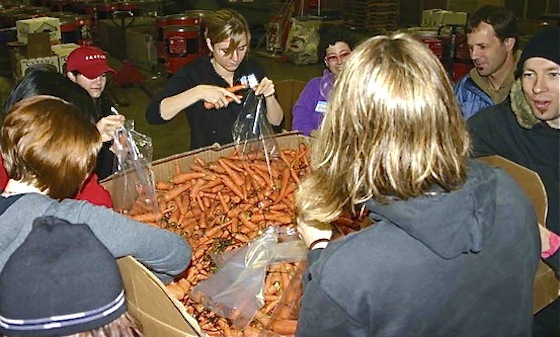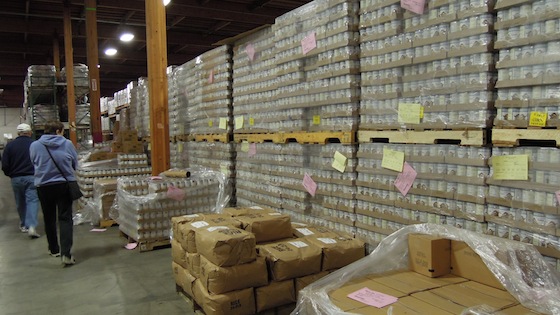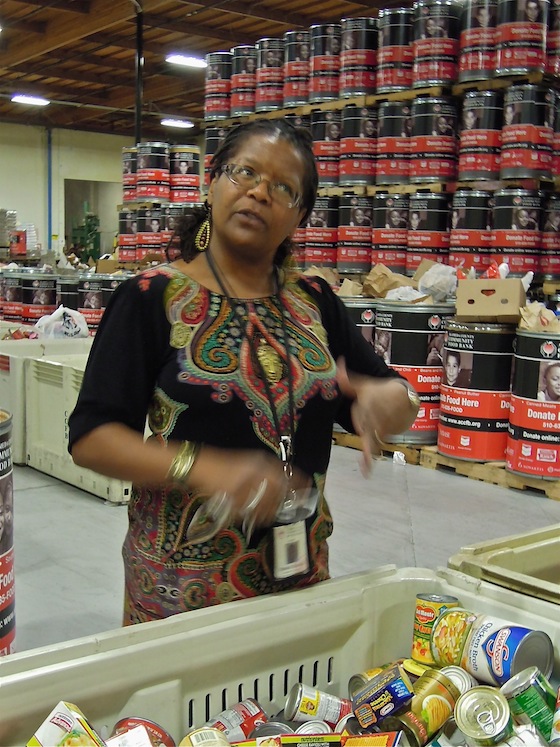
Volunteer coordinator, Sheila Burks, an inspiring dynamo in a constant blur of motion, delivers an impassioned orientation and leads a tour of the facilities.
“Everything you touch here will positively benefit someone you’ve never met,” says Burks, rallying the assembled volunteers who range from retired people with time on their hands and a desire to do good to those who need to work off their speeding tickets through community service hours. Every year, 6,000 groups and 9,000 individuals generously give their time to sort cans and boxes, bag fruit and vegetables, pack cartons of food, as well as answer the emergency food helpline (which gets more than 3,500 calls a month) and assist with office work.
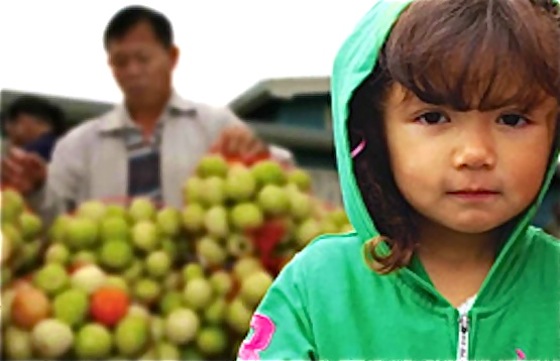
Photo courtesy of Alameda County Community Food Bank
“Hunger doesn’t take a holiday,” says Burks. “And now there is a new face to hunger, people who never thought they would need to call us. A teacher who got laid off and can’t feed his kids, a massage therapist who broke her arm and can’t work, families who find they need a little help at the end of the month to make it to their next check.”
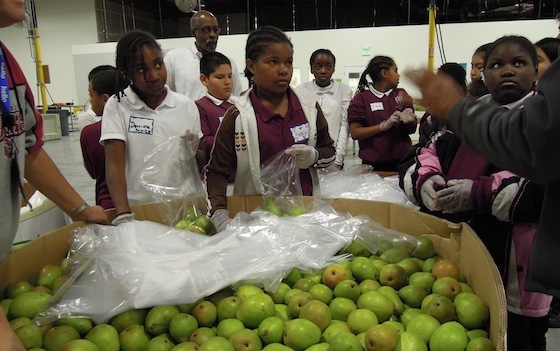
As she shows us around the huge warehouse, I meet some of the volunteers pitching in on this Wednesday afternoon. A group of 5th graders from St. Martin de Porres Catholic School in Oakland are eagerly bagging pears. They tell me “it’s fun” and “it’s good to help people” while school principal Maurice Harper, Jr. confides that, “Many of our school’s families benefit directly from food assistance. So involving students in a hands-on way empowers them.”
A majority of the food bank’s volunteers come as part of a group: company sponsored employee associations, Girl and Boy Scouts troops, religious organizations—one cohort in their 70’s and 80’s arrives faithfully every 2 weeks to fill backpacks for the Children’s BackPack Program, which provides low-income school children a bag of food to help their families through the weekend.
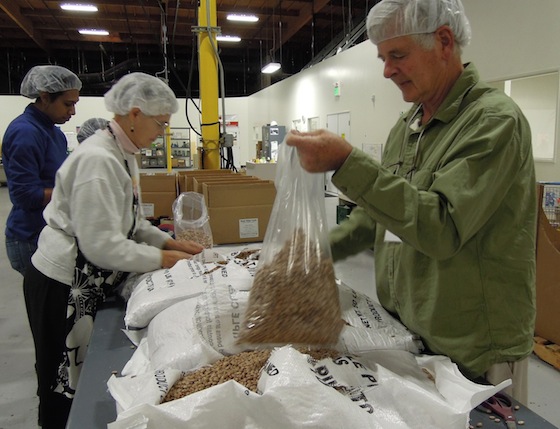
Looking distinguished even in their hairnets, Oakland residents, George and Jane Collier, both retired anthropology professors from Stanford University, have been volunteering at the food bank for the past three years. They enjoy the work “because it’s socially important, flexible, good exercise and you get to meet interesting people.” Today the couple is divvying up 50-pound sacks of pinto beans, scooping out 5 pounds of speckled legumes into separate plastic bags. Jane admits that she likes bean duty, compared to certain summertime assignments, such as sorting plums and kiwis, “which can get a little squishy.” As specialists in indigenous cultures of southern Mexico, the couple is worldly, well–traveled and appalled at the state of American society today. “Even the poorest indigenous people in southern Mexico have subsistence farming to grow themselves something to eat,“ says George. “The extreme income inequality in America is not found in other countries and it’s only recently—since Reagan—that we have so many homeless and hungry people.”
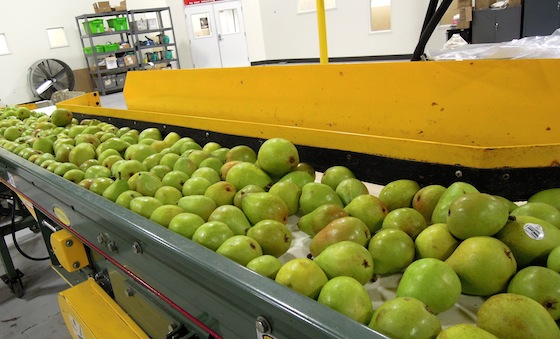
I find the repetitive motion of bagging scores of firm, green pears or scooping mounds of speckled beans somehow makes palpable the overwhelming hunger needs in our food-rich state. Six years ago, the Alameda County food bank went through 1,000,000 pounds of fresh produce a year. Now that million pounds, often trucked in directly from farms in 800-pound boxes, is distributed in only one month—a 12-fold increase.
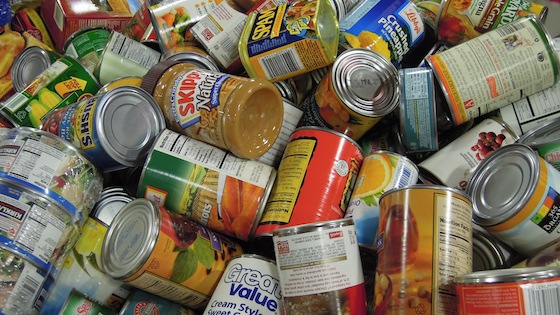
While dropping a few cans of baked beans, creamed corn or cranberry sauce in one of the red and black barrels scattered around the Bay Area may feel like a quick fix, what food banks really need is cash and people-power. Because they are buying foodstuffs in such enormous bulk, they can take the couple of dollars you’d spend on one jar of peanut butter and buy half a dozen jars. The time required to process food donations also eats up a lot of resources. As this article from Slate.com makes clear, “Food dropped off by well-meaning citizens needs to be carefully inspected and sorted. A personal check, by contrast, can be used to order what’s needed without placing extra burdens on the staff.”
Besides distributing food to Alameda County’s neediest citizens since 1985, the Community Food Bank conducts several pro-active initiatives: nutrition education classes, anti-hunger advocacy and an outreach program in five languages to help people through the complicated process of applying for our under-utilized food stamp program—now called CalFresh.
After I layered a carton with cans of tuna, chili and soup, topped by boxes of cereal and rice, its 10 pounds felt formidable, like a force that might be able to keep the hunger at bay, for one family, even for a few days. I found it heartening to engage in some physical action against the exponentially increasing hunger in our community. Not surprisingly, a recent study showed that volunteering enriches your feeling of purpose, lowers your stress and actually improves your health:
Sheila Burks says, “My faith is renewed every day. I’m inspired by the volunteers. It’s phenomenally powerful to see people share their time and energy to restore the peace of mind and dignity of strangers.”
A reminder from the food bank: hunger doesn’t end when the holidays are over, the need will still be there in early 2012, even though the focus may not be.
The food bank’s website gives details on volunteering opportunities, how to donate money, organize a food drive or join the advocacy team to promote policy change.
